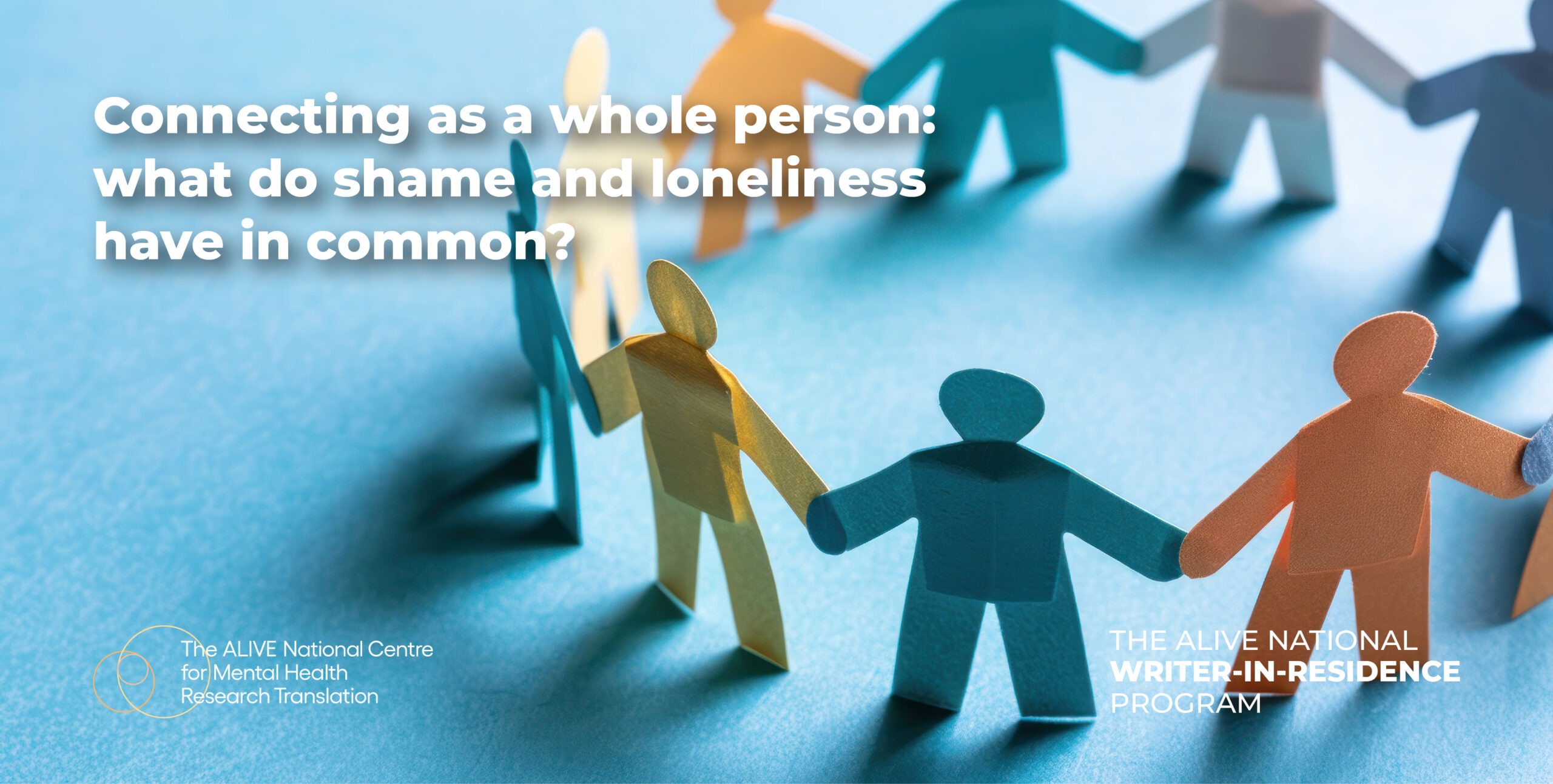Interested in our initiative? Submit your email to receive an invite to the alive collective.
Menu
Interested in our initiative? Submit your email to receive an invite to the alive collective.
An invitation to consider the biology of belonging.

Written by Johanna Lynch – University of Queensland
In this issue we will reflect on the central role that relationships have on our wellbeing as humans: ‘being human is a team sport’. We cannot thrive without safe, tuned in, and available relationships in the places we live, work, learn, and play. We need safe, connected relationships for quality sleep, relaxed creativity, language acquisition, biological regulation, neurodevelopment and connectivity, and social capacity.1
We can relax and eat, tell and digest stories, let our guard down, laugh, play, create, dance, express ourselves, concentrate, and listen well when we are in the company of safe people. This is the Social Engagement System that Stephen Porges has described as being a balance of sympathetic and parasympathetic nervous systems engaging and connecting.2 Although originally ridiculed by the medical establishment, the attachment research of William Blatz, Mary Ainsworth, and John Bowlby is now foundational learning for anyone seeking to understand patterns in relationships and their impact on child development and wellbeing.3-6 Daniel Siegel describes safe attachment that includes experiencing safety, ‘feeling felt’ and responded to, and being soothed.7 Feeling able to seek comfort when hurt, unwell, and upset is strong predictor of later wellbeing.8 There are some ‘sensitive periods’ of our life (e.g., before the age of three and adolescence)9,10 where our human connections are especially important to development of our sense of self and neural connectedness to our world.
Perhaps you remember the feeling of joy at being ‘found’ and ‘seen’ when playing ‘peek a boo’ with a child? This moment epitomises the physical delight of being socially connected. This is a biology of belonging – a complex whole person experience.
Our relationships with other people are so important that we have refined sensory systems and meaning-making processes designed to monitor and protect our connection to other people. Human beings are social mammals – we need each other, and we have complex ways of sensing if a person is safe to interact with that include gaze, touch, tone of voice (prosody), proximity, and cultural ways of knowing. We tune in moment by moment to people around us, and our bodies run a background check in our memories for any alarming shapes, colours, movements, sounds, smells, words, and so much more.
Connectedness is so hard wired into us that early infant reflexes to hold onto a finger, reach out, or turn to nurse are all designed to reconnect us with our caregiver.11 Donald Winnicott even went so far as to describe an early child-parent bond as an essential dyad where the parent’s brain is a tuned-in adapting and nurturing ‘scaffold’ 11p. 196 for normal neurodevelopment and social growth. Stephen Porges summarises this in his phrase: “the goal of civilisation is to be safe in another’s arms”.12 Those who have a whole person (not narrow psychiatric) understanding of trauma as a relational wound describe trauma as “repeatedly being left psychologically alone in unbearable emotional pain”13p.xxii or a “violation of an expectancy to be safe with another”.12 This kind of terrible aloneness can happen in the presence of people.
Feeling alone in the world is highly threatening for humans. Social rejection has some shared neural pathways to physical pain.14,15 Loneliness has well documented impacts on health including increased mortality and higher risk of cardiovascular, metabolic, and neurological disorders.16-19 Emotional neglect – although rarely studied alone and still not well understood – has been linked to decreased physical and mental health.20-22 Those who study social belonging link loneliness, marital distress, and lack of perceived social support as blocks to the basic human need to “form caring social bonds and be loved by others” 23p.90 and see these experiences as public health concerns. The multilayered experience of belonging matters. 23-25
Safe belonging with others (and to ourselves in solitude) is so important to lifelong health and moment by moment comfort that our bodies have an early warning signal if connectedness is threatened in any way. Safe connection can be threatened by invasion of our physical and moral integrity, confusion of our sense that we know our place in our social world, and various forms of ostracism or dehumanising exclusion.1 This is especially so in cultures that have more of a sense of transgression of collectivist values.26
Do you remember the tense uncomfortable feeling in our stomach and throat when our caregivers used a sharp tone of voice to stop us hurting ourselves before we could understand words? Their ‘Uhh-ahh’ sound in our preverbal years, and sharp urgent ‘no’ later, could guide us towards safety and connection. The feeling of potential disconnection in that tone of voice is so important to our physical and social survival it will stop us in our tracks. Being out of attunement with our caregiver triggers a social signal and physiological reflex we can’t ignore that makes us blush, turns our gaze to the floor, makes us go still, and causes our shoulders to droop.11 It is “a relatively wordless … [and]… acutely self-conscious state” that alerts our caregiver to tune in and reconnect.27p.60 Judith Herman notes that these postural changes, facial signals, and hiding behaviours are similar to appeasement displays in other social animals and are recognisable across cultures.27
This tense misattuned feeling is hard wired into us as an alarm when we are at risk of losing our social connections. It can happen when we experience disapproval, bullying, rejection, racism, and ostracism. It can happen when we hurt someone else, and they withdraw from us. It can also happen when we are neglected, ignored, treated as invisible, and given the silent treatment (including when the caregiver is unwell, preoccupied by other needs, or absent – what Judith Hermans calls ‘psychologically unavailable’27). I even get a dose of it when I am about to do something that exposes me to potential exclusion – like giving a speech. It is a social emotion.
I was first given cause to reflect on the alarm of disconnection reading the work of Louis Cozolino in his book The Neuroscience of Psychotherapy. In his chapter on the ‘interpersonal sculpting of the brain’, he describes a bodily experience when we experience social misattunement – where we expected positive tuned in connection (what Allan Shore calls ‘sparkling-eyed pleasure’28p.65) and instead our caregiver is not tuned in (preoccupied, disconnected or disapproving). This is a sudden neurological shift from sympathetic engaging tone to parasympathetic switch off. This bodily reaction is an early warning signal of social risk and a potential need to repair connection. If left without a timely attuned social response it becomes a chronic experience of hopelessness and helplessness.28
The tense ‘I’m at risk of being disconnected’ feeling has many causes and unfortunately can be misinterpreted as shame. Some describe this as toxic shame where we can feel “irreparably flawed, unworthy and unlovable, and that our social position and social bonds are under threat”.29p.4 When disconnection is misunderstood as shame it can have far reaching impacts that often increase disconnection from others and from self – what some call self-stigma30 or self-alienation.31,32 One of my patients (with permission) described this as “I am in prison with the worst cellmate in the world – me”. Donald Nathanson described a ‘compass of shame’ that named shame responses that often exacerbate disconnection: avoidance, attacking self, withdrawing socially, and attacking others.33 So many of these responses to feeling shame in response to disconnection are contributors to mental distress including addictions and compulsions. In fact, recent studies of internet gaming disorder for example, name ‘compensatory internet use’ 34 as a response to emptiness, an identity void, or “unfulfilled” attachment needs.35 Although the links between attachment needs and addiction36,37 and loneliness and mental illness are well studied, enquiring about relationships, loneliness, and fear of disconnection is not routine healthcare practice.
Brene Brown has described shame as ‘fear of being disconnected’.38 Instead – I would describe a fear of disconnection that is often misinterpreted as shame. Misinterpreting (and misdiagnosing) disconnection as shame can lead to well-meaning but misguided treatments aimed at building self-esteem and increasing self-compassion without addressing the aching loneliness of the person’s heart. Conflating shame with ‘trauma’ can also distract us from potential pathways to healing the grief of disconnection. Although linked or braided together,39 trauma, dissociation, disorganised attachment, and shame27 are distinct processes requiring tailored and personalised care.
Years ago, I had some trauma-informed training on shame that I have refined into my clinical approach to shame. People who experience neglect or trauma as children have three strong reasons to interpret their disconnection as shame and three different potential pathways to healing:
“If you feel loved, your brain becomes specialised in exploration, play and cooperation. If you are frightened and unwanted, it specialises in managing feelings of fear and abandonment”41 Embodied experiences of feeling safe and connected are part of the healing of shame.
There is an extensive literature around shame that has become disconnected from the natural and purposeful physiological tension that humans feel when they feel socially isolated. Those who have survived childhood trauma and neglect often have a constant experience of that tension. They experience it if they do anything that other people might disapprove of (including asking for things they need or challenging the status quo). They experience it if someone ignores or ghosts them or if there are any traces of disapproval or disconnection (or even micro-expressions of disgust) in someone’s facial expressions or movements. They are exquisitely tuned into disconnection. Sometimes, when they have done nothing wrong – they describe feeling ‘guilty’ and other times this tension about being disconnected is misnamed ‘shame’ and interpreted to be a sign of personal (not a relational) inadequacy. If it is a constant experience, it can lead to inner experiences of emptiness, self-alienation, self-loathing, and suicidal ideation.32,42 The tension of imminent social exclusion can also trigger amnesia, numbing, and other depersonalising dissociative experiences if associated with overwhelming memories of aloneness.8,43 This shame reaction has direct impacts on physiology and health44-48 and is the reason that there are calls for ‘shame-sensitive’ trauma informed practice.29
It is important to understand that the tense embodied ‘fear of disconnection’ feeling that is often misnamed ‘shame’ is a purposeful warning sign with a social goal – to help us reconnect:
This tension can be caused by a fear of exposing ourselves to rejection (a risk of disconnection) that modulates our self-expression to be socially acceptable and can be an invitation to courageously practice being ourselves (something Brene Brown calls ‘shame resilience’). This is often an ordinary growing-up feeling that comes with new tasks of disagreeing with others or asking for our own needs to be met. It also enables pro-social respect and attunement towards others.
The tension of fear of disconnection can be caused by someone withdrawing from us or our own internal conscience alerting us to when we have hurt someone else. This is what is often called guilt. It is specific, about something we have done or not done or said or not said. It has a specific date, time, and place, and is never about who we are as a person. This tension of disconnection is a prompt or invitation to repair the relationship through the doorway of apology and restitution.27
Finally, the fear of disconnection can be because other people have harmed us with disconnection, invasion or confusion.1 Pulling away from unsafe people is a natural response to pain caused by the adults in our life when we were powerless and dependent on them for connection. It is not our defects that caused the disconnection. It is not shame. This disconnection leads towards mourning our loss of safe connection, and needing comforting present day sensory and social experiences of belonging. As Frank Putnam said in an interview: “First and foremost, the client must be safe and feel safe, or no treatment will be effective”
In all of these experiences, the core relational need for a sense of safety is fundamental. The natural biology of alarm at disconnection helps us to understand and discern whether courage, apology, or felt security and love are needed on the pathway to healing. Rather than the “shame of unrequited love”27p.4 in the game of peek- a-boo we need to be feel seen and heard, we need a safe person to ask for comfort. The biology of belonging offers a whole person, strengths-based, embodied, relational, and healing-oriented approach that tunes into and cares for the lonely pain inside shame and trauma.
The author would like to thank Rebecca Moran for her review of an earlier draft.
About the writer

Dr Johanna Lynch MBBS PhD FRACGP FASPM Grad Cert (Grief and Loss) is a retired GP who writes, researches, teaches, mentors and advocates for generalist and transdisciplinary approaches to distress that value complex whole person care and build sense of safety. She is an Immediate Past President and Advisor to the Australian Society for Psychological Medicine and is a Senior Lecturer with The University of Queensland’s General Practice Clinical Unit. She spent the last 15 years of her 25 year career as a GP caring for adults who are survivors of childhood trauma and neglect. She consults to a national pilot supporting primary care to respond to domestic violence.
An invitation to consider the links between wholeness and healing.
Read moreWorld Mental Health Day Event 10 October 2024
Read moreCongratulations to Rebecca Moran and team from the Big Anxiety Research Centre for TheMHS 2024 Lived Experience Led Storytelling Award!
Read moreThe ALIVE Mental Health Research Virtual Café Translation Conversations #22
Read moreAn invitation to consider the biology of belonging.
Read moreAn invitation to see social determinants of health in a new light.
Read moreAn invitation to critique current understanding of mood as disorder.
Read moreAn invitation to see the interconnected embodied whole.
Read moreby Next Generation Researcher Network
Read moreCongratulations to this year’s awardees and stay tuned for the next call out!
Read moreA Call to Action to [Re]form National Mental Health and Well-Being, March 2024
The ALIVE National Centre Next Generation Researcher Network Capacity Building Funding Scheme 2024
Read moreTo address capabilities needs, career pathways, conditions in research organisations and identify lived-experience approaches and practices for research integration
Read moreThis handbook has been co-designed by members of the Co-Design Living Labs Network.
Find out more about the noticeboard feature and how to contribute
Read moreA capacity building and career development initiative of the ALIVE National Centre for Mental Health Research Translation
Read moreThis is a monthly event focused on bringing people together to discuss and translate the findings in mental health research.
The ALIVE National Centre is funded by the NHMRC Special Initiative in Mental Health.
The ALIVE National Centre for Mental Health Research Translation acknowledges the Traditional Owners of the land on which we work, and pay our respects to the Elders, past and present. We are committed to working together to address the health inequities within our Aboriginal and Torres Strait Islander communities.
WARNING: Aboriginal and Torres Strait Islander viewers are warned that this site may contain images and voices of deceased persons.
This map attempts to represent the language, social or nation groups of Aboriginal Australia. It shows only the general locations of larger groupings of people which may include clans, dialects or individual languages in a group. It used published resources from the eighteenth century-1994 and is not intended to be exact, nor the boundaries fixed. It is not suitable for native title or other land claims. David R Horton (creator), © AIATSIS, 1996. No reproduction without permission. To purchase a print version visit: https://shop.aiatsis.gov.au/



The ALIVE National Centre for Mental Health Research Translation is funded by the National Health and Medical Research Council (NHMRC) Special Initiative in Mental Health GNT2002047.